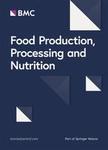Application of light emitting diodes (LEDs) for food preservation, post-harvest losses and production of bioactive compounds: a review
作者机构:Department of Dairy Science and Food TechnologyInstitute of Agricultural SciencesBanaras Hindu UniversityVaranasiUttar Pradesh221005India
出 版 物:《Food Production, Processing and Nutrition》 (食物生产加工与营养(英文))
年 卷 期:2022年第4卷第1期
页 面:85-94页
核心收录:
学科分类:080903[工学-微电子学与固体电子学] 0832[工学-食品科学与工程(可授工学、农学学位)] 1004[医学-公共卫生与预防医学(可授医学、理学学位)] 1001[医学-基础医学(可授医学、理学学位)] 0809[工学-电子科学与技术(可授工学、理学学位)] 08[工学] 080501[工学-材料物理与化学] 0805[工学-材料科学与工程(可授工学、理学学位)] 080502[工学-材料学]
主 题:Light emitting diodes Food preservation Anti-microbial Bioactive compounds Non-thermal
摘 要:Light-emitting diode (LED) technology is a new non-thermal food preservation method that works by converting light energy into heat. LED has potential to revolutionize crop production, protection and preservation. This technology is economical and environmentally friendly. LEDs have been shown to improve the nutritive quality and shelf life of foods, control the ripening of fruits, induce the synthesis of bioactive compounds and antioxidants and reduce the microbial contamination. This technology also has great scope in countries, where safety, hygiene, storage and distribution of foods are serious issues. While comparing this technology with other lighting technologies, LEDs can bring numerous advantages to food supply chain from farm to fork. In case of small growing amenities which exploit only LEDs, energy expenditure has been successfully reduced while producing nutritious food. LEDs can be used to give us better understanding and control over production and preservation of food with relation to spectral composition of light. LEDs also play significant role in food safety by inactivating the food borne pathogens. Therefore, LED lighting is a very effective and promising technology for extending shelf life of agricultural produce by increasing disease resistance and with increased nutritional values.



